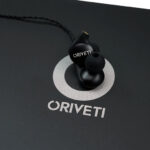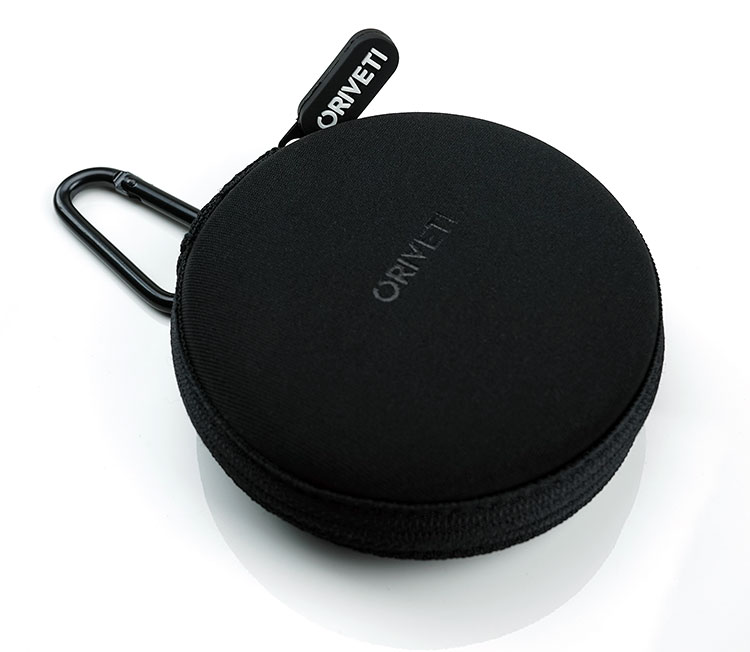In this feature, we review the ORIVETI BASIC which is a very affordable single 10mm dynamic driver universal IEM for budget audiophiles. It is priced at $99 SRP.
Disclaimer: This sample was sent to us in exchange for our honest opinion. Headfonics is an independent website with no affiliate links or partnerships. We thank the team at ORIVETI for giving us their support.
Click here to read more about ORIVETI products we have previously featured on Headfonics.
Note, this review follows our current scoring guidelines which you can read up on in more detail here.
There is a certain “tongue in cheek” to calling an IEM “BASIC” and then tasking the marketing department to produce a compelling punchline to go along with it in the marketplace. Yet, in deference to the excellent Primacy last year, that is just what Oriveti has done with their new entry-level $99 IEM.
I would describe the BASIC as, well, anything but basic though. Your average OEM $5 bargain bin colored IEM with faded blister packaging is basic, your stock IEM in a mobile phone box is probably basic also.
The Oriveti BASIC, on the other hand, gets the full Oriveti packing and build experience and as such, I would position it at the upper budget tier of IEMs.
What Is The Pitch?
For those who wanted a taste of the Primacy look and feel but felt the $299 asking price was out of their league, the BASIC is positioned to be much more accessible at $99. It is also a slightly different tonal tweak appealing more to the consumer end of the market but with some audiophile sensibilities.
As such the visual flair and packaging of the BASIC breeds a certain familiarity with its bigger sibling that augurs well in terms of recognition and attention to detail.
Note however the BASIC is not being pitched to iGadget and Android users specifically. There is no in-line or remote control with the BASIC making this more of a straightforward set of single dynamic driver IEMS for pure listening.
That being said, at 16Ω and 108dB, it will live fairly happily off a smartphone as well as a dedicated DAP so there is something of a crossover appeal to the BASIC in terms of market audience.
Design
The BASIC is a single custom-made titanium-coated 10mm dynamic driver IEM. The driver is encased in a shallow 2-piece CNC-milled aluminum housing finished in a similar style to the Primacy with the same black coating and white “Oriveti” moniker on the front.
The BASIC follows a slightly more traditional circular chassis design than the more elegant teardrop aesthetic of the Primacy, however, like the Primacy, the BASIC design flow is soft and very nicely curved without a sharp edge in sight. In my hand, they kind of look like a pair of M’n’M’s they are that smooth.
The aluminum housing is accented at the top with a set of standard MMCX connectors made of soft TPE on the outside and hard PP plastic on the inside. They are actually quite long but feel very solid and quite durable.
The nozzle length is relatively short but the curved angular form factor descending from the rounded metal chassis does give it some additional length. That being said much will depend on the tip you use in terms of size and materials for isolation.
The bass port is no longer stealthily placed at the tip of the MMCX connector and instead can be found at the base of the chassis just before the nozzle.
Stock Cable
With the Primacy now upgraded to a new 8-wire braided cable, the BASIC now comes with the previous cable that was shipping with the older Primacy version. This is a 4-wire braided detachable MMCX terminated cable measuring 1.2m in length. It is terminated with a gold-plated 3.5mm straight stereo jack as well as gold-plated MMCX connectors on the other end.
There is no solid y-split tube barrel with a chin strap such as you get on the Primacy. Instead, there is a more simplistic low-profile black heat shrink wrap and adjustable black tube chin strap.
The braided cable itself is soft, pliant, and with low microphonics which is a big bonus at this level. It certainly is a step up from the cheaper copper cables you sometimes get bundled with, even on costlier CIEMS.
I presume this is still a silver-plated cable from their older marketing literature and whilst they advertise it as an accessory still on the website you can no longer physically buy it. Instead, you get the $89.99 8-wire from the new Primacy as the default accessory wire. Previously the 4-wire version was being sold at $30.
Comfort & Isolation
The BASIC is lighter than the Primacy and despite the long MMCX stem, it is a very comfortable fit with no lateral movement and a nice natural fold over the ear for the cable. You can also elect to choose a spare set of soft ear hooks by attaching them to the cable but for me, these have a little bit of unnecessary girth to what is a fairly low-profile fit.
I do sense those with glasses might find the length of the stem somewhat of an awkward bedfellow given its over-the-ear design and the addition of the hooks may also be a nonstarter.
Isolation will depend on the choice of tips. Interestingly Oriveti elected not to supply any foam tips with the BASIC. The Primacy comes with 2 foam sizes and was an excellent pairing for passive noise isolation.
Instead, you do have a wide range of tips, both single and double flange but no foams so there will be a slight diminution in isolation on the BASIC compared to the Primacy.
The good news is that the dual flange silicone tips are excellent both in terms of insertion depth and isolation and preferable to the single bore tips that didn’t feel as steady or kept as much noise out.
Accessories & Packaging
For $99 you can’t really beat the packaging of the BASIC. The only company that really comes close to the volume of accessories is Trinity Audio and for quality, RHA. At least at this price level. Packaging is also very similar to the level of the $299 Primacy making it a stand out on the retail shelf.
Inside you get a wide range of silicone tips, a single carabiner for hooking onto the carry case, two soft memory hooks for attaching onto the cable, and a brand new redesigned semi-soft zipped carry case.
As mentioned before there are no foam tips in the BASIC package but you do get some good dual flange tips which are my preferred tips for use with the BASIC. the sizes of the tips are as follows:
- 2 x medium for the dual flange silicone tips
- 2 x large & medium single-bore silicone tips
- 1 x small set of single bore tips
The new zip-locked semi-stiffened black pill case is actually something I prefer to the older metal screw thread box. Despite it being slightly less robust it is lighter and roomier for tips, cables, and the IEM. The inclusion of the carabiner offers additional flexibility for attaching to straps and belts when on the go.
Sound Impressions
Summary
Tonally the BASIC is reasonably dark with some low-end warmth via sub to mid-bass response that’s fairly north of neutral. The BASIC also displays an elevated upper midrange to lower treble boost for percussion presence and a treble performance that falls off rather quickly post-5k.
There isn’t so much of a lower mid-range dip so I wouldn’t say it displays a purposefully v-shaped recessed instrumental and vocal positioning. Rather it is more of a case that the low end and lower treble of the BASIC are just that bit more boosted.
As such instrumental work and vocals will seem a further back delivering a perceptibly open and spacious sound with a decent note body but not quite the incisive and accurate imaging you would get on more intimate or BA designs.
Overall this is a musical and smooth-flowing IEM with a better fix on modern genres that need plenty of low-end rumble rather than complex detail-focused sources where vocal presence and nuanced detail need to be at the fore.
Bass
The BASIC bass signature is fairly measured sub-bass to upper-bass slope with a 5-6dB differential between 20Hz to 300Hz where it plateaus off into the lower mid and mid-range.
The BASIC hits hardest from around 20-30Hz to 80-100Hz so you won’t hear any roll-off or lack of depth in the BASIC’s bass performance.
This is an excellent extension for an IEM at this price point. With that slope though there is no mid-bass emphasis so the power of the BASIC bass performance is more in its sub-bass rumble than an overly boosted 150Hz impact.
You will also get the hallmarks of a natural dynamic driver delivery with some very good body and texture. This type of bass frequency slope also means a lack of upper bass bloat clouding any desired low-end instrumental clarity leaving the mids to sound fairly free and spacious.
On the flip side, the dynamic driver inside the BASIC is medium-paced at best with a lingering decay that prevents it from being classed as tight and well-defined.
Mids
Mids are relatively neutral in comparison to the elevated bass and treble response but with a slight dip around 2-3k before increasing the energy levels into the upper mids and on into the lower treble.
The lack of a lower mid-range dip, something typical in a v-shape means that the BASIC instrumental note doesn’t sound brittle or overly thin. Combined with the impressive low-end power you get a nice smooth and natural sounding timbre.
Instruments do however sit further back in the mix so whilst this offers a fairly welcome sense of spaciousness in the BASIC’s soundstage I did find the imaging a bit vague and less vivid and engaging.
Vocals on the BASIC are reasonably clear and smooth, though, like its instrumental positioning, they are not terribly forward and at times sound like they are competing with instrumental passages, especially when the low-end gets an injection of energy.
Slightly lower-pitched vocals generally perform better than higher-pitched vocal work that crosses into that little dip 2-3k dip though in almost all cases the BASIC delivered a sibilant free signature.
Treble
The BASIC has a reasonable boost in its upper mids and lower treble adding a bit of clarity and presence to percussion attacks and a tiny bit of sparkle overall but after around 5-6k it dips fairly quickly with an early roll-off that takes a little away from the BASIC in terms of air and headroom.
Note body is still good though with a natural-sounding delivery. Lower treble sibilance, as with the mids, is few and far between.
For some, this means there might be a perceptible lack of top-end clarity though I don’t really find the detail to be lacking. It simply is not to the fore quite as much as the bass response though a little bit more so than the mid-range performance.
Hence that slightly dark tonal quality to the BASIC’s presentation. For one thing, this isn’t a peaky performance and certainly lacks any harsh strident tones so overall it is at least a fairly forgiving treble signature.
Click on page 2 below for our recommended pairings and selected comparisons.






